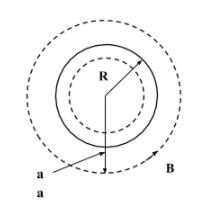
Magnetic field at a distance a from long current carrying wire is proportional to
A. $\dfrac {1}{a}$
B. $\dfrac {1}{{a}^{2}}$
C. $\dfrac {1}{\sqrt {a}}$
D. $\dfrac {1}{{a}^{\dfrac{3}{2}}}$
Answer
565.5k+ views
Hint: This problem can be solved using the Biot-Savart law which gives the expression for magnetic field in a long current carrying wire. Biot-Savart law helps us to calculate the magnetic field due to a steady current. From the expression for Biot-Savart law, we can infer that the magnetic field in a long current carrying wire is independent of the relative angular position of the point of observation. But, it depends on the perpendicular distance from the wire.
Formula used:
$B= \dfrac {{\mu}_{0}I}{2 \pi a}$
Complete step-by-step answer:

According to Biot-Savart law, the expression for magnetic field in a long current carrying wire is given by,
$B= \dfrac {{\mu}_{0}I}{2 \pi a}$ …{1}
Where, ${\mu}_{0}$ is the constant
a is the distance from the wire
I is the current flowing through the wire
From the equation. (1), it can be inferred that,
$B \propto \dfrac {1}{a}$
Hence, the magnetic field at a distance from a long current carrying wire is proportional to $\dfrac {1}{a}$.
So, the correct answer is option A i.e. $\dfrac {1}{a}$.
So, the correct answer is “Option A”.
Note: Students may think that the electrons never stop moving, so it will always produce an electric field and hence the magnetic field. But in reality, this does not happen. Electrons move in a random direction in a conductor and thus, they get cancelled. Hence, the net electric field and magnetic field will be zero. When potential difference is applied across the terminals of the wire, electrons move in a specific direction. Hence, it will constitute current. As long as the potential difference exists, current through the wire exists and thus magnetic field exists for that same duration.
Formula used:
$B= \dfrac {{\mu}_{0}I}{2 \pi a}$
Complete step-by-step answer:

According to Biot-Savart law, the expression for magnetic field in a long current carrying wire is given by,
$B= \dfrac {{\mu}_{0}I}{2 \pi a}$ …{1}
Where, ${\mu}_{0}$ is the constant
a is the distance from the wire
I is the current flowing through the wire
From the equation. (1), it can be inferred that,
$B \propto \dfrac {1}{a}$
Hence, the magnetic field at a distance from a long current carrying wire is proportional to $\dfrac {1}{a}$.
So, the correct answer is option A i.e. $\dfrac {1}{a}$.
So, the correct answer is “Option A”.
Note: Students may think that the electrons never stop moving, so it will always produce an electric field and hence the magnetic field. But in reality, this does not happen. Electrons move in a random direction in a conductor and thus, they get cancelled. Hence, the net electric field and magnetic field will be zero. When potential difference is applied across the terminals of the wire, electrons move in a specific direction. Hence, it will constitute current. As long as the potential difference exists, current through the wire exists and thus magnetic field exists for that same duration.
Recently Updated Pages
A man running at a speed 5 ms is viewed in the side class 12 physics CBSE

The number of solutions in x in 02pi for which sqrt class 12 maths CBSE

State and explain Hardy Weinbergs Principle class 12 biology CBSE

Write any two methods of preparation of phenol Give class 12 chemistry CBSE

Which of the following statements is wrong a Amnion class 12 biology CBSE

Differentiate between action potential and resting class 12 biology CBSE

Trending doubts
What are the major means of transport Explain each class 12 social science CBSE

Which are the Top 10 Largest Countries of the World?

Draw a labelled sketch of the human eye class 12 physics CBSE

Explain sex determination in humans with line diag class 12 biology CBSE

Explain sex determination in humans with the help of class 12 biology CBSE

Differentiate between homogeneous and heterogeneous class 12 chemistry CBSE




